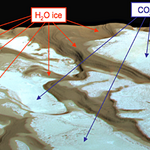Paleontology

An 80-million-year-old dinosaur fossil unearthed in the Gobi Desert of Mongolia demonstrates that miniaturization, long thought to be a hallmark of bird origins and a necessary precursor of flight, occurred progressively in primitive dinosaurs.
The find, described in the September 7 issue of the journal Science, is made up of the fossilized bones of a new dinosaur the researchers have named Mahakala, and includes portions of its skull, forelimb and hindlimb, as well as much of the vertebral column.
Mahakala is an early evolutionary offshoot of the group of carnivorous dinosaurs known as…

American paleontologist Edward Drinker Cope, died on 12 Apr 1897. Cope is best remembered for his rivalry with O.C. Marsh, often referred to as the Great Bone Wars. These two antagonists shared a lot in common: a fierce sense of competition, unbounded arrogance and a deep driving force that led them to unbelievable lengths to outdo each other. Cope led many great expeditions into the American West and was prolific in the naming of dinosaur species. Cope was also an ichthyologist, an evolutionist, and a founder of the Neo-Lamarckian school of thought.
But enough of the boring stuff, here's a…

New scientific findings suggest that a large comet may have exploded over North America 12,900 years ago, explaining riddles that scientists have wrestled with for decades, including an abrupt cooling of much of the planet and the extinction of large mammals.
The discovery was made by scientists from the University of California at Santa Barbara and their colleagues. James Kennett, a paleoceanographer at the university, said that the discovery may explain some of the highly debated geologic controversies of recent decades.
The period in question is called the Younger Dryas, an interval of…

Last weeks's M 7.6 West Java earthquake was detected, located and sized after only 4 minutes and 38 seconds by the German Tsunami Early Warning System (GITEWS) currently under construction in Indonesia. The location of the earthquake has been established after just 2 minutes and 11 seconds. For comparison: The Pacific Tsunami Warning Center (PTWC) in Hawaii published the location and magnitude of this earthquake after about 17 minutes.
Such a rapid analysis was possible due to the new software system called "SeisComP" (Seismological Communication Processor) developed by GFZ Potsdam that was…
Ice loss from glaciers and ice caps is expected to cause more global sea rise during this century than the massive Greenland and Antarctic ice sheets, according to a new University of Colorado at Boulder study.
The researchers concluded that glaciers and ice caps are currently contributing about 60 percent of the world’s ice to the oceans and the rate has been markedly accelerating in the past decade, said Emeritus Professor Mark Meier of CU-Boulder’s Institute of Arctic and Alpine Research, lead study author. The contribution is presently about 100 cubic miles of ice annually -- a volume…

Scientists say that using data from the Mars Express mission and numerical models they can determine how the orbit of Mars around the Sun accounts for the origin and perennial occurrence of water ice at the Martian South Pole.
The OMEGA instrument on board Mars Express had already found previously undetected perennial deposits of water-ice sitting on top of million-year old layered terrains and those provided strong evidence for recent glacial activity.
The OMEGA instrument on board ESA’s Mars Express has characterised the types of ice deposits present in the South polar cap of Mars as the…

Many earthquakes in the deep ocean are much smaller in magnitude than expected. Geophysicists from the Woods Hole Oceanographic Institution have found new evidence that the fragmented structure of seafloor faults, along with previously unrecognized volcanic activity, may be dampening the effects of these quakes.
Examining data from 19 locations in the Atlantic, Pacific, and Indian oceans, researchers led by graduate student Patricia Gregg have found that “transform” faults are not developing or behaving as plate tectonic theory says they should. Rather than stretching as long, continuous…

A University of Utah study shows how various regions of North America are kept afloat by heat within Earth’s rocky crust, and how much of the continent would sink beneath sea level if not for heat that makes rock buoyant.
Of coastal cities, New York City would sit 1,427 feet under the Atlantic, Boston would be 1,823 feet deep, Miami would reside 2,410 feet undersea, New Orleans would be 2,416 underwater and Los Angeles would rest 3,756 feet beneath the Pacific.
Mile-high Denver’s elevation would be 727 feet below sea level and Salt Lake City, now about 4,220 feet, would sit beneath 1,293…

A sheet of molten rock roughly 10 miles thick spreads underneath much of the American Southwest, some 250 miles below Tucson, Ariz. From the surface, you can't see it, smell it or feel it.
But Arizona geophysicists Daniel Toffelmier and James Tyburczy detected the molten layer with a comparatively new and overlooked technique for exploring the deep Earth that uses magnetic eruptions on the sun.
Toffelmier, a hydrogeologist with Hargis + Associates, Inc., in Mesa, Ariz., graduated from ASU’s School of Earth and Space Exploration in 2006 with a master’s degree in geological sciences. Tyburczy,…

New studies show that iron, the principal constituent of the innermost parts of the earth’s core, becomes unusually ‘soft’ at the extreme pressures and temperatures that prevail there. The findings enhance our possibility of understanding the innermost parts of the earth and how earthquakes occur.
The findings were attained by a team of Swedish and Russian researchers, who used advanced simulations on Swedish supercomputers. This new knowledge explains some of the seismic data-signals from earth tremors-that stations around the world gather and that have puzzled scientists until now.
“These…